Book contents
- Frontmatter
- Contents
- Contributors
- Part I Identification of the Living
- Chapter 1 Familiar face recognition
- Chapter 2 Unfamiliar face recognition
- Chapter 3 EFIT-V
- Chapter 4 Facial recall and computer composites
- Chapter 5 Facial ageing
- Chapter 6 Age progression and regression
- Chapter 7 Computer-assisted age progression
- Chapter 8 Facial recognition from identification parades
- Chapter 9 Virtual human identification line-ups
- Chapter 10 Computer-generated face models
- Chapter 11 Recognising and learning faces in motion
- Chapter 12 Facial image comparison
- Chapter 13 Three-dimensional facial imaging
- Part II Identification of the Dead
- Index
- Plate Section
- References
Chapter 3 - EFIT-V
Evolutionary algorithms and computer composites
Published online by Cambridge University Press: 05 May 2012
- Frontmatter
- Contents
- Contributors
- Part I Identification of the Living
- Chapter 1 Familiar face recognition
- Chapter 2 Unfamiliar face recognition
- Chapter 3 EFIT-V
- Chapter 4 Facial recall and computer composites
- Chapter 5 Facial ageing
- Chapter 6 Age progression and regression
- Chapter 7 Computer-assisted age progression
- Chapter 8 Facial recognition from identification parades
- Chapter 9 Virtual human identification line-ups
- Chapter 10 Computer-generated face models
- Chapter 11 Recognising and learning faces in motion
- Chapter 12 Facial image comparison
- Chapter 13 Three-dimensional facial imaging
- Part II Identification of the Dead
- Index
- Plate Section
- References
Summary
Introduction
In the event of a crime, police officers often rely on a witness to provide a comprehensive account of the incident. In some circumstances, the witness has to convey a description of the perpetrator based only on a brief encounter. The pertinent question is how is it possible to accurately convey the perpetrator’s face when the image only exists as a memory in the witness’s mind? This corresponds well to the typical circumstances under which a trained police officer will subsequently work with the victim (or other witness to a crime) in an attempt to produce a facial likeness or facial composite of the perpetrator. Unless the witness is a gifted artist it is unlikely that he or she will be able to provide a reliable sketch of the offender/perpetrator. Typically, assuming of course that the attacker is unknown to the witness, he or she will first be asked to provide a detailed verbal description of the attacker and to recount the incident in as much detail as possible. When the interview is complete, an attempt is then made to produce a likeness under the guidance of a specially trained operator. Whilst sketch artists are still used widely in the USA, this process will most likely (in the UK at least) use some form of computerised facial composite system. A facial composite system is a tool designed to allow the expression of the facial appearance retained in the witness’s memory in some tangible form, such as a digital image or computer print-out. The desired outcome is that the generated composite be of sufficient accuracy that subsequent display to members of the public will result in direct recognition and that the details of the suspect will be supplied to the police. In many cases, a generated composite may not be accurate enough to produce a definite ‘hit’ but may nonetheless provoke members of the public who recognise basic similarities to provide the names of possible suspects. In most cases, it is the combination of the composite with other basic information such as age, build, domicile and the type of crime that results in the provision of suspect names.
- Type
- Chapter
- Information
- Craniofacial Identification , pp. 24 - 41Publisher: Cambridge University PressPrint publication year: 2012
References
- 7
- Cited by



